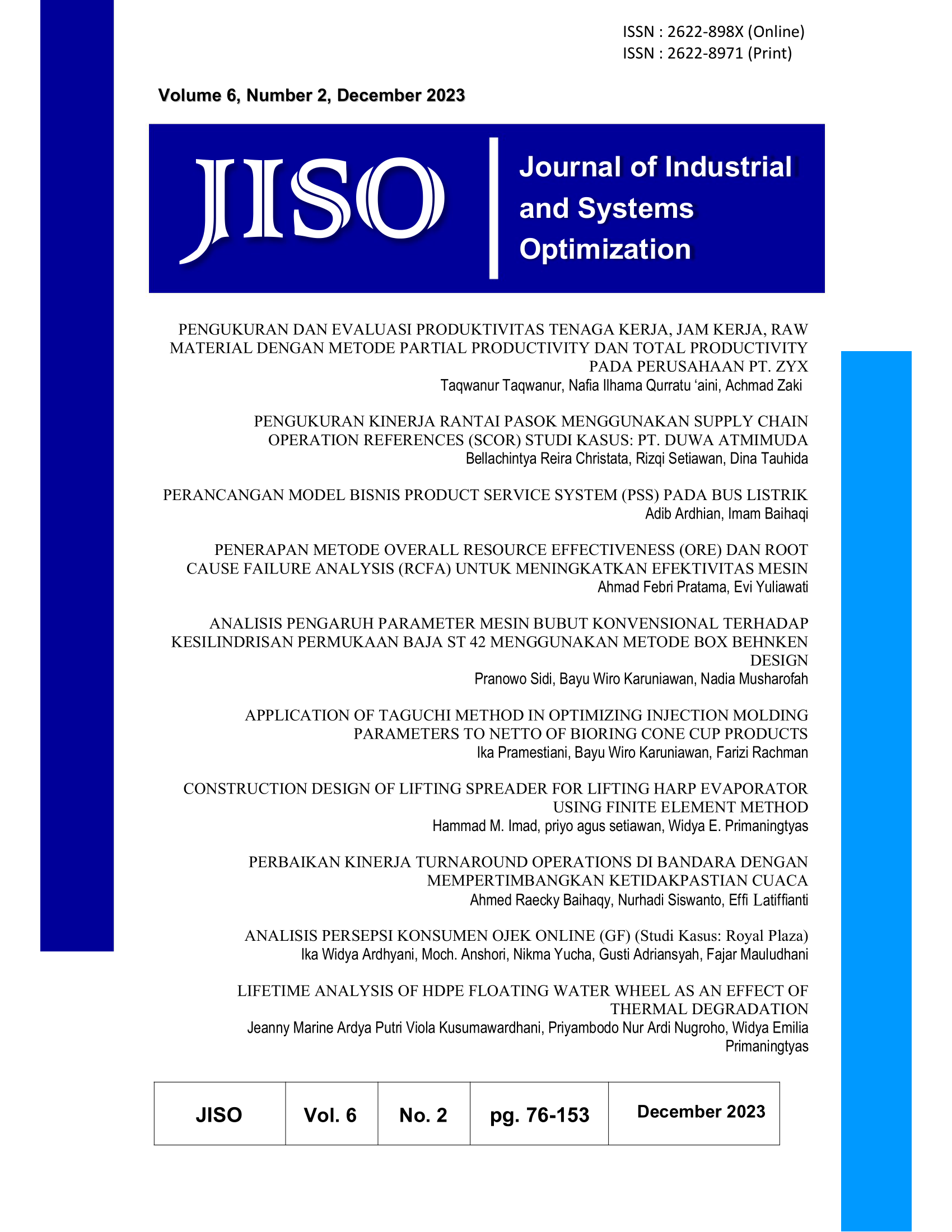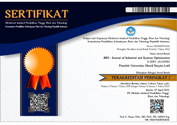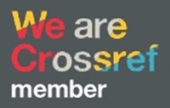PENGUKURAN DAN EVALUASI PRODUKTIVITAS TENAGA KERJA, JAM KERJA, RAW MATERIAL DENGAN METODE PARTIAL PRODUCTIVITY DAN TOTAL PRODUCTIVITY PADA PERUSAHAAN PT. ZYX
DOI:
https://doi.org/10.51804/jiso.v6i2.76-84Keywords:
Partial Productivity, Total Productivity, FIFO, ABC ClasificationAbstract
Productivity performance is one of the main factors that contribute greatly to improving company performance and customer satisfaction. So far, PT. ZYX never measures productivity performance but only records input and output results without conducting analysis for improvement so that this has an impact on the company's development which is not as expected. To develop its business PT. ZYX conducts business by measuring productivity performance, conducting evaluations to find out the root causes and corrective action plans to increase productivity performance. Measuring productivity based on the partial productivity method for labour criteria, working hours, raw materials and also using the Total Productivity method. This productivity will provide information on the highest and the lowest productivity values. Calculation of the value of Partial Productivity - the lowest labour force was 170 pcs/man.day, the value of partial productivity - the lowest machine working hours was 14.61 pcs/min while the value of partial productivity - the lowest raw material was 6.67 pcs/kg. For the lowest total productivity value was 19.60. To find the root of the problem used fishbone with considering several factors such as labour, methods, machines, and materials in each productivity criteria. After that, the improvement plan was made such as revising SOPs, making change over work instructions, training, implementing FIFO, evaluating skills, improving raw material layout based on ABC classification, searching new suppliers, improving change over schedules, making incentive and punishment procedures.
Kinerja produktivitas merupakan salah satu faktor utama yang memberi kontribusi yang sangat besar pada peningkatan kinerja perusahaan dan kepuasan pelanggan. Selama ini PT. ZYX tidak pernah mengukur kinerja produktivitas tetapi hanya mencatat input dan hasil output tanpa melakukan analisis untuk perbaikan sehingga hal ini berdampak pada berkembangnya perusahaan yang tidak sesuai harapan. Untuk mengembangkan usahanya PT. ZYX melakukan usaha dengan mengukur kinerja produktivitas, melakukan evaluasi untuk mengetahui akar permasalahannya serta rencana tindakan perbaikan untuk meningkatkan kinerja produktivitas. Mengukur produktivitas berdasar metode partial productivity untuk kriteria tenaga kerja, jam kerja, raw material dan juga menggunakan metode Total Produktivity. Produktivitas ini akan memberi informasi nilai produktivitas tertinggi dan terendah. Perhitungan nilai Partial Productivity – tenaga kerja terendah 170 pcs/man.hari, nilai partial productivity – jam kerja mesin terendah 14.61 pcs/min sedangkan nilai partial productivity – raw material terendah 6.67 pcs/kg. Untuk nilai total productivity terendah 19.60. Untuk mengetahui akar permasalahan digunakan fishbone dengan mempertimbangkan beberapa faktor seperti tenaga kerja, metode, mesin, dan material di setiap kriteria produktivitas. Setelah itu dibuat rencana perbaikan seperti revisi SOP, membuat instruksi kerja change over, pelatihan, penerapan FIFO, evaluasi skill, memperbaiki layout bahan baku berdasar ABC classification, mencari supplier, memperbaiki jadwal change over, membuat prosedur incentive dan punishment.
References
Afianti, H. F., & Azwir, H. H. (2017). Pengendalian Persediaan Dan Penjadwalan Pasokan Bahan Baku Import Dengan Metode ABC Analysis Di PT Unilever Indonesia, Cikarang, Jawa Barat. Jurnal IPTEK. https://doi.org/10.31284/j.iptek.2017.v21i2.200
Fauziah, S.M., F. S. M., & Rangkuti, S. (2020). Analisis Penerapan Standar Operasional Prosedur, Keselamatan Dan Kesehatan Kerja Terhadap Produktivitas Kerja Kru Ka (Studi Kasus Pada PT. Kereta Api Indonesia (Persero) Divisi Regional I Sumatera Utara). Bisnis-Net Jurnal Ekonomi Dan Bisnis. https://doi.org/10.46576/bn.v3i2.1004
Fithri, P., & Sari, R. Y. (2016). Analisis Pengukuran Produktivitas Perusahaan Alsintan CV. Cherry Sarana Agro. Jurnal Optimasi Sistem Industri. https://doi.org/10.25077/josi.v14.n1.p138-155.2015
Gustina Amran, T., & Yasin, M. (2017). Peningkatan Produktivitas Menggunakan Objective Matrix Dan Fault Tree Analysis Di Divisi Assembly Master Cylinder. Jurnal Teknik Industri. https://doi.org/10.25105/jti.v7i1.2205
Habibah, H., & Herwanto, D. (2022). Analisis Produktivitas Tenaga Kerja pada Bagian Produksi Menggunakan Metode Produktivitas Parsial di PT Prima Kemasindo. Jurnal Serambi Engineering. https://doi.org/10.32672/jse.v7i1.3882
Heizer, J., & Render, B. (2017). Manajemen operasi manajemen keberlangsungan dan rantai pasokan. Jakarta: Salemba Empat.
Laratiwi, B. N., Mulyanto, T., & Yamin, M. (2021). Analisis Produktivitas Produksi Gula Aren Dan Gula Kelapa Di PT X Menggunakan Metode Multi Factor Productivity Measurement Model (MFPMM). Jurnal Ilmiah Teknologi Dan Rekayasa. https://doi.org/10.35760/tr.2021.v26i1.3531
Nursetiowati, O., & Dewi, K. (2023). Pentingnya Penerapan Metode FIFO Dalam Meningkatkan Standart Kualitas Bahan Baku Di Hotel. Jurnal Sains Manajemen.
Pratiwi, D. N., & Saifudin, S. (2021). Penerapan Metode Analisis ABC Dalam Pengendalian Persedian Bahan Baku Pada PT. Dyriana (Cabang Gatot Subroto). Solusi. https://doi.org/10.26623/slsi.v19i1.3000
Samuel, M., & Sadalia, I. (2021). Analysis of Strategy in Increasing Employee Productivity through the Establishment of Organizational Culture with Organizational Commitment as a Variable between in PT . Gading Mas Indah , Malang. International Journal of Research and Review, 8(1), 439–447. https://www.ijrrjournal.com/IJRR_Vol.8_Issue.1_Jan2021/IJRR047.pdf
Downloads
Published
Issue
Section
License
Copyright (c) 2023 JISO : Journal of Industrial and Systems Optimization

This work is licensed under a Creative Commons Attribution-ShareAlike 4.0 International License.
With the receipt of the article by JISO Editorial Board and the decision to be published, the copyright regarding the article will be transferred to JISO. The copyright transfer form can be downloaded here.
JISO has the right to multiply and distribute the article and every author is not allowed to publish the same article that was published in this journal.
JISO is licensed under a Creative Commons Attribution-ShareAlike 4.0 International License.
Under the following terms:
Attribution — You must give appropriate credit, provide a link to the license, and indicate if changes were made. You may do so in any reasonable manner, but not in any way that suggests the licensor endorses you or your use.
ShareAlike — If you remix, transform, or build upon the material, you must distribute your contributions under the same license as the original.














